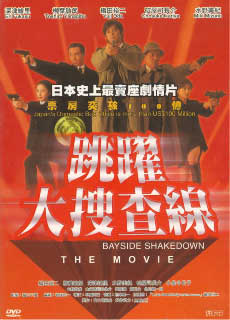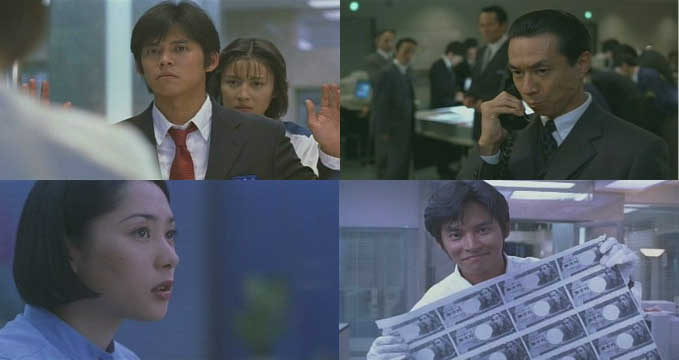Bayside Shakedown: The Movie
(Odoru daisosasen)

Director: Katsuyuki Motohiro
Production Company: Fuji TV
Year: 1998
Running Time: 119 minutes
In 1997 Fuji TV produced the standard 11 episodes of a mini-series
that detailed the lives of members of a small police precinct in Tokyo. The
show became a huge hit and this marked the beginning of the Bayside Shakedown
phenomenon. The season on TV only lasted that one year but the phenomenon
still continues on the big screen. The following year “Bayside Shakedown:
The Movie” was released and grossed over $100 million at the box office –
an enormous hit. For some odd reason they waited five more years for a sequel
but the near cult adoration for the first film finally forced them to produce
“Bayside Shakedown 2” in 2003 and this film actually managed to out do the
first at the box office – over $150 million which easily made it the most
popular film of the year. At this point, they finally realized they had a
franchise on their hands and have made two semi-spin off films that focus
on specific characters from the first two films but are not in a complete
sense Bayside Shakedown films – “Negotiator” and “The Suspect: Muroi Shinja”
(not reviewed here yet) both released in 2005.

So what makes this product so popular? Like any lasting TV show the answer
is fairly simple – extremely likable characters and great chemistry between
them. Though I have unfortunately not been able to find the TV series with
English subtitles (and I would sell my brother’s first born to do so) I think
I can assume that the first two films were basically very similar to them
– only longer with slightly bigger budgets. The movies are basic TV shows
– unlike for example in Hollywood where producers feel they have to ramp
up the movie versions of TV shows a hundred fold in terms of budget and special
effects. Fuji instead gave the audience exactly what they wanted – to see
the cast of characters again in basically the same environment interacting
with one another – and ponder the same questions – will Sumire and Aoshima
ever realize how much they love one another – will Yukino ever say yes to
Mashita. Sure crimes are committed and solved but these tend not to be particularly
complex – that’s not the appeal of these shows – it’s the wonderful mix of
comedy, drama and on occasion melodrama that sucks you in and makes you want
to stay.

There are a few themes that carry through the first three films that I suppose
are universal but seem especially salient in Japanese society – or at least
in Japanese films. The sense of obligation to your colleagues and to your
boss – which leads to performing the best you can to save face – your own
but even more importantly for the person who is responsible for you. The
flip side of this comes into play as well – to avoid responsibility in order
not to lose face – something the bureaucrats in the films are masters of.
In these films, the simple action of taking responsibility while others fade
into the background is in itself heroic and often the turning point in the
films. Jurisdiction and team work are other themes that run through the films.
Bayside is a local precinct – looked down upon by the elite central headquarters
and they are often shunted aside to perform menial tasks while the big boys
take over – but success usually only comes when the men with their noses
on the street are allowed to perform their duties and when various authoritative
factions work together for a common goal – the Japanese way in theory – but
these films poke great fun at the reality of the egos, politics, infighting
and the artificial lines of division that make this very difficult.In the
second film, one character finally orders "Forget rank, forget class" to
try and solve the crime by having everyone work together.

In the first few minutes, the main characters are all introduced to the audience.
First, there is Aoshima (Yuji Oda) a young emotional mischief making detective
who can also be as sharp as a nail and is willing to jump into anything.
He works alongside Sumire (Eri Fukasu) – the beautiful but feisty female
cop whose sharp chic haircut dramatically reveals her freckle filled face
and the perfectly placed mole on her left cheek – she always gets her man
– except in love. Then there is the wise old rumpled Inspector Waku (Chosuke
Ikariya) who is nearing retirement but always has something left to give.
Mashita (Yasuke Santa Maria) – his role becomes much more prominent in the
next two films - is the computer guy who works with the newly promoted Yukino
(Miki Mizuno) in trying to solve one of the crimes. Finally, there is the
dour faced tightly sprung Muroi (Toshiro Yanagiba) who was once a part of
the precinct but has moved on to headquarters where he has to tread carefully
to move up the ladder. His relationship with Aoshima is one of the dramatic
focal points of the first two films – they have promised to look out for
one another – one cop in the bureaucratic maze, the other on the streets.
As comic relief there are the three supervisors who run the precinct, but
who spend most of their time sucking up to Headquarters or looking for ways
to cut expenses.

Three crimes come into the mix – from petty thefts in the precinct to a morbid
murder to a high profile kidnapping. The crimes are separate but begin to
intertwine with one another. Sumire is put on the thefts and concludes that
the robber is a master costume changer as he may have also been responsible
for thefts from a girl’s locker room. Mashita and Yukino get assigned to
the murder case – a dead body has been discovered floating in the middle
of the river (Inspector Waku hopes that it floats to the other side where
it will fall out of their jurisdiction, but no such luck) that has a teddy
bear sewn into the stomach. The killer may run a web site for murder. The
major case though is the kidnapping of a police commissioner – this is too
high profile for the locals to handle so Headquarters takes it over with
Muroi in charge and the Bayside cops are forced to perform lowly duties.
This doesn’t sit too well with either Waku who has known the Commissioner
since they were rookies or with Aoshima who wants to be in the middle of
the case. When the inspector disappears, Aoshima goes to the psycho teddy
bear killer for help ala “Silence of the Lambs” – and then he sees a puff
of colored smoke – “it’s like the Kurosawa film” (“High and Low”) and the
frantic chase is on.

The film begins with light comedy and slowly moves eastward into more serious
territory and by the end it is drenched in gut clutching melodrama with a
race to the hospital and salutes along the way. For this kind of film, this
is nearly perfect – they aren’t aiming for high art or anything glamorous
or edgy or experimental – it’s just good TV with very appealing characters
doing what they love to do in the best way they can.

My rating for this film: 8.5









